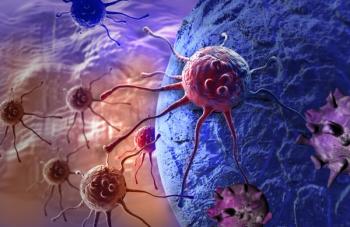
- ONCOLOGY Nurse Edition Vol 26 No 8
- Volume 26
- Issue 8
Vismodegib, a Hedgehog Pathway Inhibitor for Adults With Locally Advanced or Metastatic Basal Cell Carcinoma
Vismodegib is for the treatment of adults with metastatic basal cell carcinoma, or locally advanced basal cell carcinoma that has recurred following surgery or who are not candidates for surgery, and who are not candidates for radiation.
Approved Drug: Vismodegib (Erivedge)
Indications
Treatment of adults with metastatic basal cell carcinoma, or locally advanced basal cell carcinoma that has recurred following surgery or who are not candidates for surgery, and who are not candidates for radiation.
Mechanism of Action
Vismodegib is a Hedgehog pathway inhibitor. The Hedgehog pathway is essential to fetal development, but signaling is tightly controlled after the fetus is developed. In basal cell carcinoma, it appears that the pathway is reactivated, leading to malignant progression. Vismodegib binds to and inhibits Smoothened, a transmembrane protein involved in the Hedgehog signal transduction.
Metabolism
Vismodegib is highly permeable but not very soluble in liquids. Bioavailability of a single dose is 31.8%. More than 98% of the circulating drug components are parent drug, and the drug is highly protein-bound to plasma proteins (> 99%). Drug absorption is not influenced by food intake. Drug is primarily excreted as unchanged drug, but minor metabolites are produced by CYP enzymes. Drug is a substrate of CYP2C9 and CYP3A4 pathways, but drug appears unaffected by concurrent administration of CYP3A4 inducers or inhibitors. Drug and its metabolites are primarily eliminated by the liver, with 82% of drug recovered in the feces, and 4.4% recovered in the urine. Elimination half-life is about 4 days after continuous dosing, and 12 days after a single dose. Patient age, weight, creatinine clearance (30–80 mL/min), and sex do not effect drug exposure. Drug has not been studied in patients with hepatic or renal impairment.
Drug Administration
Oral, 150 mg taken once daily with or without food, for as long as patient derives clinical benefit. Swallow whole. If a dose is forgotten, resume dosing with next scheduled dose.
• Available in 150-mg capsules, in a bottle containing 28 capsules. Bottle should be stored at room temperature.
• Within 7 days prior to starting therapy, verify that female patients are not pregnant as drug can cause embryo-fetal death and severe birth defects.
• Drug should not be used by nursing mothers.
Patient Education
• Vismodegib capsules should be taken whole once daily. Do not crush the capsules, and do not make up a skipped dose. The next dose should be taken as scheduled.
• Patients should NOT donate blood or blood products while taking vismodegib, or for 7 months after the last drug dose.
• Women of childbearing age who are sexually active should use highly effective contraception during and for 7 months following the last dose of drug.
• Women of childbearing age who have unprotected sex, think that their birth control has failed, or think that they are pregnant need to talk to their providers right away.
• Men who are sexually active with female partners should use a condom with spermicide during treatment and for 2 months after the last dose, even if they have had a vasectomy, as drug may be present in semen.
• Men need to notify their healthcare providers right away if their partners may have become pregnant.
Hedgehog Signaling Pathway Inhibitors
Vismodegib (Erivedge) is the first of the Hedgehog (Hh) signaling pathway inhibitors. The Hedgehog pathway is critical for organs in the embryo to develop and to move to the correct body location, especially body parts that are bilateral. In addition, Hh is crucial for ensuring that the developing tissues grow to the exact size, have the right cellular content, and are located in the correct place. The Hh gene was identified in studying the fruit fly and body segmentation. When the Hh signaling proteins were turned off, the fly embryo did not develop correctly, and resembled a hedgehog, hence the name. Different parts of the embryo have different concentrations of Hh signaling proteins. This helps the anterior and posterior segments, the right and the left, as well as the top and bottom segments of the embryo, to develop correctly. The most helpful example is the formation of the digits of the right and left hands, which depend upon Hh signaling (Sonic) in the embryo.[1]
The Hh pathway is critical in embryogenesis and then is “on” or activated. It is significantly less present and less commonly activated in the adult. It is believed to play a role in regulating adult stem cell function, especially maintenance and regeneration of adult tissue. In addition, the Hh pathway is necessary for hair follicle cells to move from the G0 or resting phase into the growth phase.[2]
In mammals, there are three Hh genes: Sonic, Indian, and Desert Hedgehog. These genes code for a secreted protein, or ligand, the best studied of which is Sonic. Normally, the Sonic Hh ligand is not present, and when not present in the tissue, the pathway is not active. In the resting state, the Pitched (PTCH) receptor prevents activation of the Hh pathway by inhibiting Smoothened (SMO). When Sonic (the ligand) is present, it binds to the PTCH receptor on the cell surface, and causes the PTCH receptor to move into the cell and be degraded. This releases control on SMO, which is located within the cell. When PTCH is degraded, SMO moves from the inside of the cell to the cell surface (ie, outside the cell), and it activates the Hh signaling pathway which leads to transcription of Hh target genes responsible for cell proliferation, differentiation, and tissue maintenance, via the Gli family of transcription factors.[3]
In many cancers, the Sonic Hedgehog pathway appears to be activated. This
• Reduces E-cadherin, which holds the epithelial cells together, as well as the tight junctions so that cells now can separate and move (invade and metastasize).
• Helps to ramp up angiogenesis by increasing angiopoietin-1 and -2, and metastases.[4,5]
• Turns on the cell cycle (cell proliferation), specifically cyclins D1 and B1, decreases the expression of the genes responsible for apoptosis, and enhances the antiapoptotic genes so that tumor cells survive.[6] The Hedgehog Patched 1 receptor (PTCH1) functions as a “gatekeeper” tumor suppressor gene that inhibits cell cycle progression in the G1-S phase as well as the G2-M phase. When it is mutated, there is rapid onset of tumor progression.
• Enhances the tumor microenvironment by turning on the stromal cells, which then secrete factors to support tumor growth.
In basal cell carcinoma, more than 90% of tumors have mutations which either inactivate Patched (loss-of-function of the gatekeeper, so that the Hh pathway can be turned on) or activate SMO to turn on the Hh pathway inappropriately. In patients with Gorlin syndrome (basal cell nevus syndrome), a rare genetic disease, the PTCH1 gene is mutated, effectively eliminating PTCH as the gatekeeper that normally inhibits SMO.[7] Thus, these patients have a very high risk of developing basal cell cancers. In pancreatic cancer, the Hh pathway is also turned on, and this influences other pathways as well as relationship of the tumor to the microenvironment.[8]
Vismodegib (Erivedge) works by binding to SMO, so that it cannot activate the Hh pathway. It is the first of the Hedgehog (Hh) signaling pathway inhibitors.
Drug Interactions
• P-glycoprotein (P-gp) inhibitors (eg, clarithromycin, erythromycin, azithromycin): may increase vismodegib serum levels with increased risk of adverse events.
• Drugs that alter gastric pH (eg, proton pump inhibitors, H2-receptor antagonists, antacids): may reduce vismodegib bioavailability and drug effectiveness.
Special Considerations
• Healthcare providers should counsel patients on pregnancy prevention, and report to Genentech any cases of exposure during pregnancy (directly in female patients, or via seminal fluid from male patients). Healthcare providers should encourage pregnant patients to participate in Genentech’s Erivedge pregnancy pharmacovigilance program, which collects information about exposure during pregnancy, and the effects on the mother and unborn child. (More information is available by calling 1-888-835-2555.)
• Drug is FDA approved based on a single-arm, multicenter, open-label two-cohort trial of 104 patients with a median age of 62 years. All patients were white. Median duration of treatment was 10.2 months. Overall response rates were 30.3% in patients with metastatic basal cell carcinoma, and 42.9% in patients with locally advanced disease. Among those with locally advanced disease, 20.6% of responding patients had a complete response. Median response duration was 7.6 months for each group.
Contraindications/Precautions
• No contraindications
• Drug is potentially embryo toxic (fetal death) and likely causes severe birth defects. Pregnancy should be avoided.
Adverse Reactions to Vismodegib by Body System
(boldface type indicates more common events, with 25% or higher incidence)
GI: Nausea, diarrhea, weight loss, decreased appetite, dysgeusia, constipation, vomiting
Musculoskeletal: Muscle spasm, arthralgias
Reproductive: Embryo-fetal death, severe birth defects, skipped periods in premenopausal women
Skin: Alopecia
General: Fatigue
Laboratory: Hyponatremia, hypokalemia, azotemia
Financial Disclosure: The author has no significant financial interest or other relationship with the manufacturers of any products or providers of any service mentioned in this article.
References:
References
1. Wilkes GM: Targeted Anti-Cancer Therapy: A Nursing Guide. Sudbury, MA, Jones and Bartlett Publishers, 2010.
2. Paladini RD, Saleh J, Qian C, et al: Modulation of hair growth with small molecule agonists of the Hedgehog signaling pathway. J Invest Dermatol 125(4):638–646, 2005.
3. BioOncology.com, Genentech, Inc: Hedgehog Research and Pathway Signaling. Available at
4. Lee SW, Moskowitz MA, Sims JR: Sonic hedgehog inversely regulates the expression of angiopoietin-1 and angiopoietin-2 in fibroblasts. Int J Mol Med 19(3):445–451, 2007.
5. Bailey JM, Mohr AM, Hollinsworth MA: Sonic hedgehog paracrine signaling regulates metastases and lymphangiogenesis in pancreatic cancer. Oncogene 28(4):3513–3525, 2009.
6. Adolphe C, Hetherington R, Ellis T, et al: Patched 1 functions as a gatekeeper by promoting cell cycle progression. Cancer Res 66:2081–2088, 2006.
7. Epstein EH: Basal cell carcinomas: Attack of the hedgehog. Nat Rev Cancer 8(10):743–754, 2008.
8. Dimou A, Syrigos K, Saif MW: Rationale for inhibition of the hedgehog pathway paracrine loop in pancreatic adenocarcinomas. JOP 12(1):1–5, 2011.
Articles in this issue
over 13 years ago
News of Noteover 13 years ago
Evolving and Expanding Treatment Options in NSCLCover 13 years ago
What's in a Number?over 13 years ago
Current Treatment Options for Non–Small-Cell Lung Cancerover 13 years ago
A Patient With Tumor Lysis Syndromeover 13 years ago
Falls in Older Adults With Cancer: A Call to Actionover 13 years ago
Clinical Hypnosis for the Palliative Care of Cancer Patientsover 13 years ago
Contemporary Issues in NSCLCNewsletter
Stay up to date on recent advances in the multidisciplinary approach to cancer.





